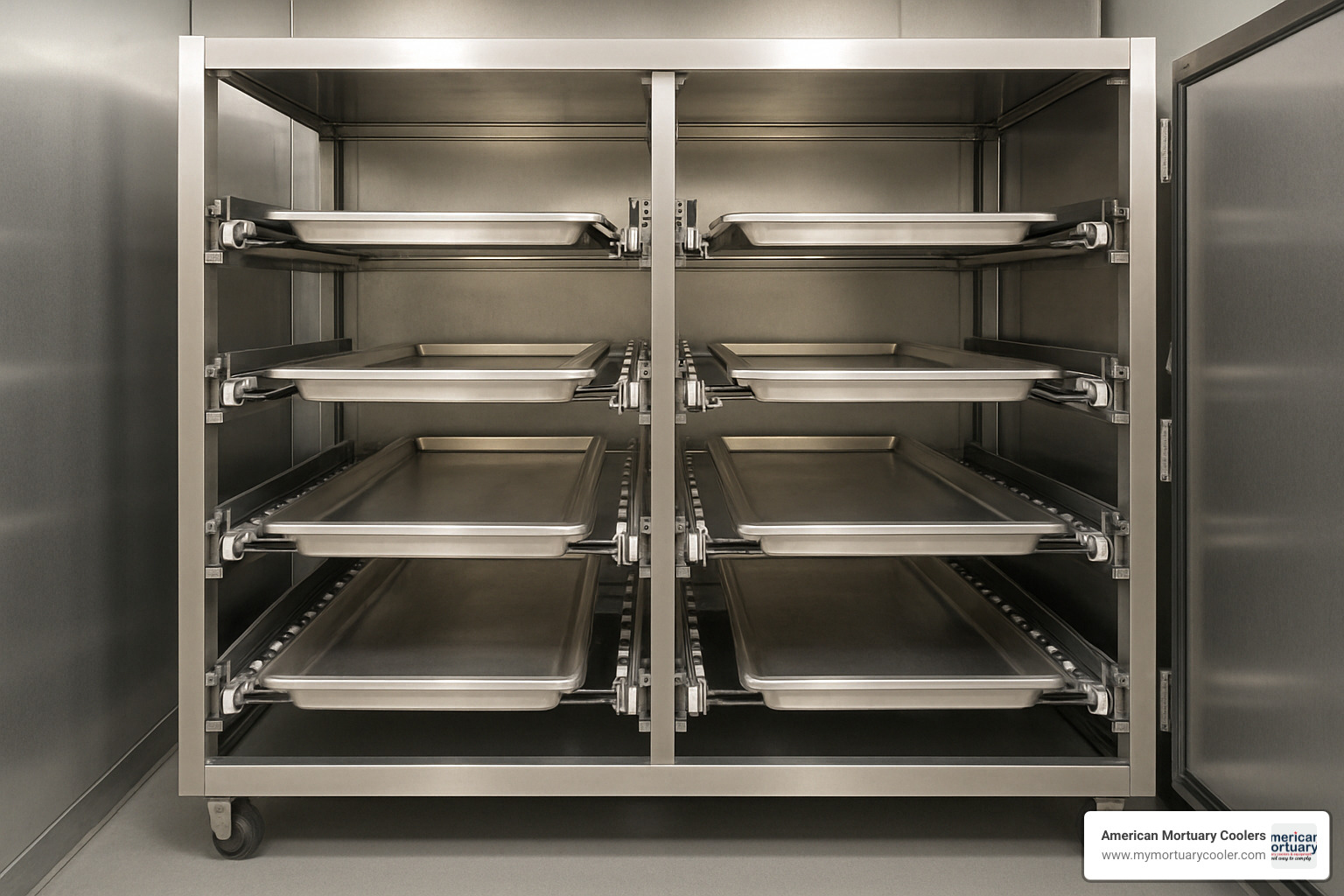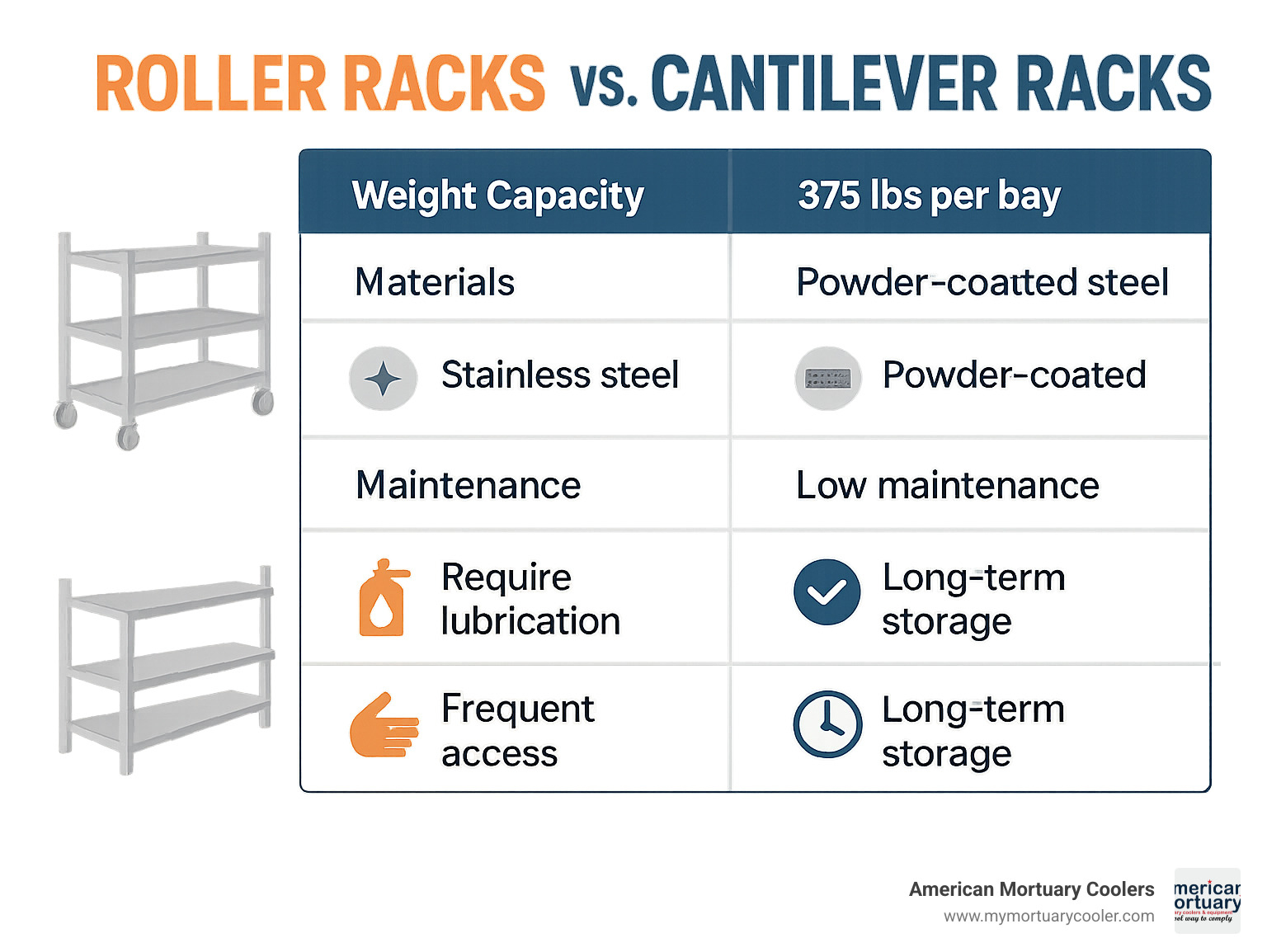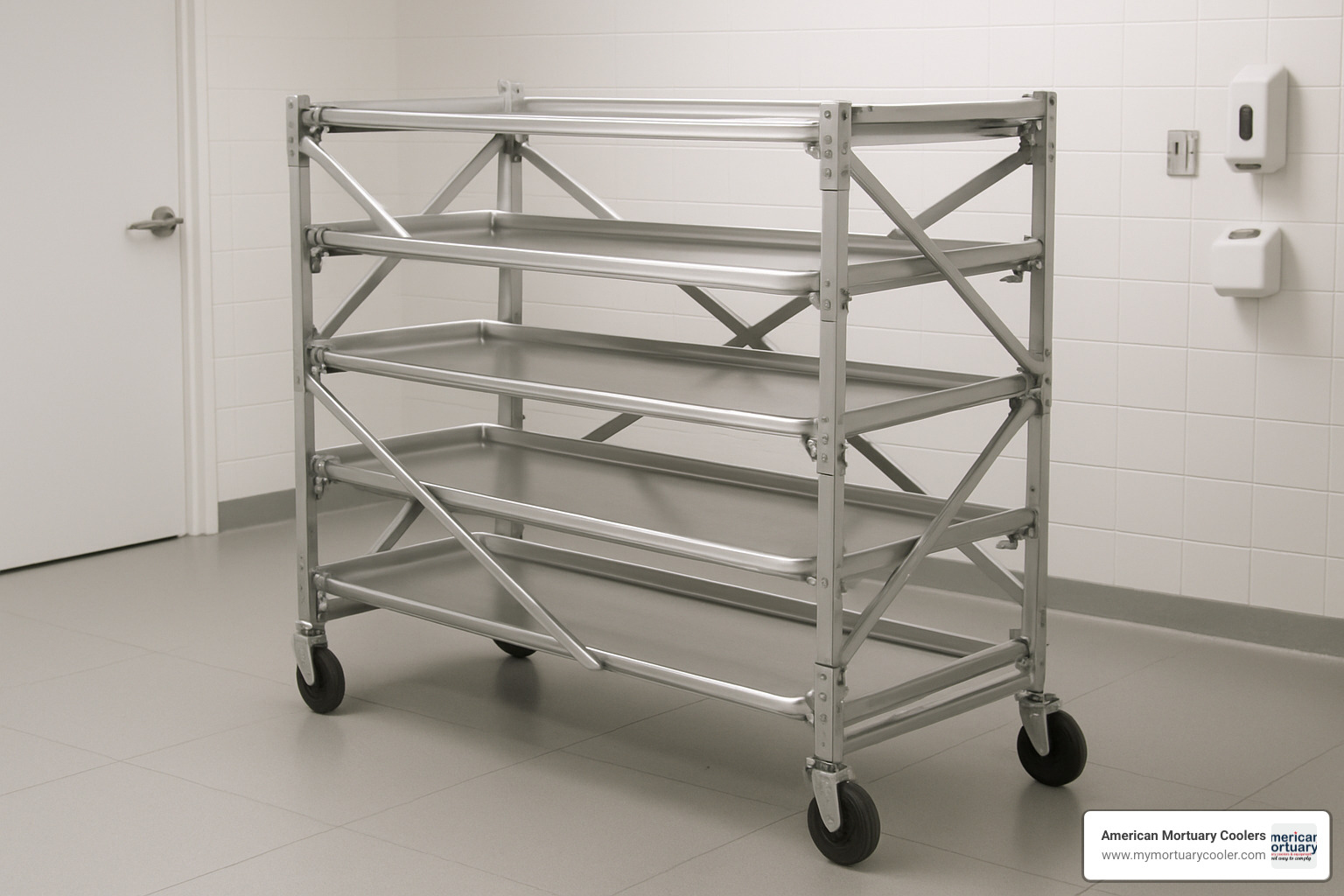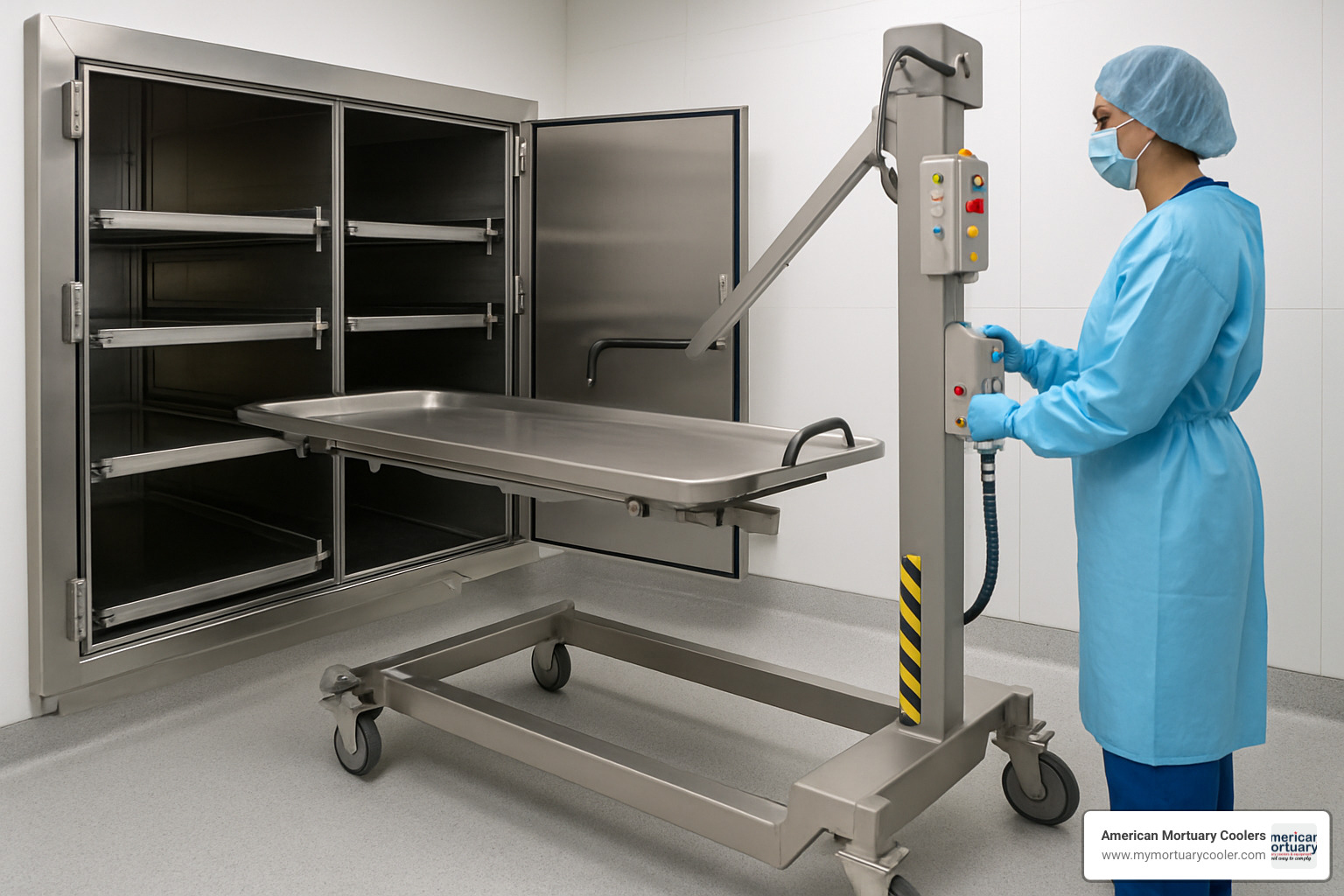Understanding Morgue Cold Storage Systems
When families entrust their loved ones to our care, they deserve nothing less than dignity and respect. That's why the storage systems we use matter so much in our industry. So, what are the freezer racks in a morgue called? You'll typically hear professionals refer to them as "mortuary racks," "cadaver storage racks," or "body storage racks." These aren't just cold metal shelves – they're specialized systems designed with both functionality and reverence in mind.
In my years working with funeral homes across the country, I've found that most facilities use one of these common rack types:
| Term | Description | Typical Use |
|---|---|---|
| Roller Racks | Feature nylon rollers for smooth body tray movement | High-volume morgues |
| Cantilever Racks | Use bracket supports to hold body trays | Smaller facilities |
| Portable Racks | Collapsible systems for temporary storage | Emergency situations |
| Bariatric Racks | Reinforced systems for larger individuals | Specialized facilities |
Each type serves a specific purpose in the careful handling of those in our care. The right system makes all the difference – not just for staff who need to safely move and access the deceased, but also for maintaining the integrity and dignity of the remains.
Modern mortuary rack systems are marvels of practical engineering. Most configurations accommodate between 2-4 bodies per shelf level, with modular designs that can grow from single units to comprehensive storage arrays. The materials matter too – durable stainless steel or powder-coated steel stands up to the cold, humid environment while meeting strict sanitation standards.
Here at American Mortuary Coolers, we've guided hundreds of funeral directors through the selection process. We understand that choosing the right storage solution isn't just about capacity – it's about honoring your commitment to families and communities. Based in Tennessee, we've supplied custom mortuary racks to facilities across all 48 contiguous states, always focusing on solutions that balance practical needs with respectful care.

Glossary for what are the freezer racks in a morgue called:
What Are the Freezer Racks in a Morgue Called?
Here at American Mortuary Coolers, we get this question all the time – what are the freezer racks in a morgue called? While you might hear different terms depending on where you are in the country, there are several standard names that most professionals recognize.
The specialized storage systems that hold the deceased in morgue freezers most commonly go by:
- Mortuary racks – This is the general catch-all term used throughout the industry
- Cadaver storage racks – A term that clearly describes their purpose
- Body storage racks – Straightforward and descriptive
- Mortuary racking systems – Often used when talking about larger installations
Despite what you might see on TV shows (those dramatic wall-mounted "morgue drawers"), most modern facilities use free-standing rack systems inside walk-in coolers. This approach makes much better use of space and simplifies maintenance and cleaning.
As Peter Rooth, a Mortuary Manager with over 20 years in the field, explains: "I have used temporary body storage systems before but one of the main advantages with modern systems is that all racks are rollered so pushing a deceased into the system is much simpler and reduces the risk of injury."
Want to explore different rack options? Check out our detailed guide here.
Defining 'what are the freezer racks in a morgue called' in Modern Mortuaries
When we discuss what are the freezer racks in a morgue called in today's mortuary settings, it helps to understand all the parts that make up these systems. Modern rack terminology has become quite specific and standardized.
The body trays are the removable platforms (typically made of stainless steel) that directly support the deceased. These trays rest on tray carriers – the framework that allows movement and proper positioning. Most systems use telescoping slide rails with nylon rollers that allow trays to glide smoothly in and out with minimal effort.
The vertical sections are called rack bays, and each bay typically contains multiple tier levels – the horizontal levels that hold individual body trays. This modular approach gives facilities tremendous flexibility. Standard morgue racks can be configured from 1 to 10 tiers high and 1 to 10 bays wide, allowing for customization based on available space and anticipated capacity needs.
Historic Terms vs. Today: what are the freezer racks in a morgue called?
The language around what are the freezer racks in a morgue called has changed quite a bit over time, reflecting how mortuary practices have evolved.
In the old days, morgues used much simpler terms and equipment. They had slabs – basic stone or concrete platforms for examination and storage. Many facilities used marble shelves because the natural stone stayed cool and was easy to clean. Early preservation methods included cooling boards designed to help lower body temperature, and basic cold chambers with simple internal shelving.
Today's terminology is much more technical, reflecting the advanced engineering behind modern equipment. We now have roller rack systems featuring nylon wheels for smooth, effortless movement of heavy trays. Cantilever storage systems use bracket supports rather than rollers for certain applications.
We also distinguish between side-loading and end-loading racks based on how bodies are transferred into the system. The most advanced options are multi-directional loading racks that allow access from multiple sides for maximum flexibility.
This shift in terminology isn't just about words – it reflects a broader evolution in mortuary science. The field has moved from basic preservation methods to sophisticated refrigeration systems designed with three key priorities: operational efficiency, maintaining the dignity of the deceased, and ensuring staff safety.
Anatomy & Variations of Morgue Freezer Racks

When we talk about morgue equipment, it's easy to overlook the thoughtful engineering behind these systems. What are the freezer racks in a morgue called? They're more than just shelves—they're specialized storage solutions designed with both dignity and practicality in mind.
At American Mortuary Coolers, we've seen how a well-designed rack system transforms daily operations in a mortuary setting. These racks don't just store bodies—they maximize your available cooler space, provide easy access to any individual without disturbing others, and significantly reduce physical strain on your staff during transfers. They maintain proper airflow for consistent cooling while offering organized, respectful storage for the deceased.
Modern mortuary racks come with impressive specifications that balance durability with functionality. Most quality systems handle approximately 375 pounds per bay, constructed from either Type 304 stainless steel (using 11-gauge tubing) or powder-coated steel for longevity in challenging environments. The nylon wheel assemblies ensure smooth, quiet operation—a small touch that makes a meaningful difference during sensitive moments.
What makes these systems particularly valuable is their modular nature. You can start with a basic configuration and expand as your needs change, with options for 1-10 tiers and 1-10 bays. This adaptability means your investment grows with your facility, without requiring complex installation or welding on-site.

Roller Racks vs. Cantilever Racks: Design & Function
When customers ask us what are the freezer racks in a morgue called, we first explain the two main design approaches they'll encounter: roller racks and cantilever racks.
Roller racks feature nylon wheels that support body trays, creating a smooth gliding motion that minimizes staff effort. These come in different loading configurations to match your facility's layout. Side-loading roller racks allow bodies to slide in from the side, which works well in spaces with limited aisle width but more wall space. End-loading roller racks do the opposite—bodies slide in from the end, requiring wider aisles but using less wall space. For facilities with flexible budgets, multi-directional loading racks offer premium versatility with access from multiple sides.
One of our installation specialists often tells clients, "For high-volume facilities handling multiple bodies daily, roller racks significantly reduce staff fatigue and injury risk. The investment pays off in reduced workplace injuries alone."
Cantilever racks take a simpler approach, using bracket supports rather than rollers. With no moving parts, they require less maintenance and often come at a more accessible price point. Available in both powder-coated and stainless steel finishes, they provide reliable service for smaller operations. The trade-off is that staff must manually lift and slide trays rather than roll them, which requires more physical effort.
Both systems fulfill the same essential purpose, but your choice typically depends on your daily case volume, staff considerations, and budget constraints.
Temporary vs. Permanent Racking Systems
Another important distinction in understanding what are the freezer racks in a morgue called is between permanent installations and temporary solutions.
Permanent racks represent the traditional approach—fixed installations designed for established morgue facilities. These robust systems feature heavy-duty materials, comprehensive configurations with multiple tiers and bays, and sometimes include seismic anchoring for safety in earthquake-prone regions. They become an integrated part of your facility's overall design and workflow.
Temporary racking systems, however, have become increasingly vital for emergency preparedness.

These portable solutions offer remarkable flexibility with their collapsible design. They can be stored compactly when not needed, then deployed rapidly—some in as little as 60 seconds—without requiring tools. Most temporary systems store up to 4 bodies per unit and include fully rollered shelves to minimize manual handling. The bottom shelf clearance (typically 40 cm) allows for trolley access, further reducing physical strain.
As one mortuary manager shared with us: "All racks are rollered so pushing a deceased into the system is much simpler and reduces the risk of injury. The bottom shelf being 40cm off the floor means we can use trolleys rather than manually load."
These temporary systems proved invaluable during the COVID-19 pandemic when many facilities needed to quickly expand their capacity. They can be deployed in mobile cold rooms, converted spaces, or alongside permanent installations to handle unexpected surges in demand.
Bariatric & Oversized Body Storage Solutions
An often overlooked aspect when discussing what are the freezer racks in a morgue called is the specialized systems designed for larger individuals.
Bariatric morgue racks address this important need with reinforced frames capable of supporting higher weights. They feature wider trays—typically 30" or 32" compared to standard 23" or 27"—and incorporate heavier-duty rollers or support brackets to ensure safe handling. These specialized units typically have fewer tiers to accommodate the additional weight while maintaining structural integrity.
These thoughtfully designed racks ensure dignified storage for larger individuals while maintaining staff safety—a dual consideration we take very seriously at American Mortuary Coolers. Some manufacturers also offer coffin-sized racks for facilities that need to store remains already in caskets.
We've noticed increasing demand for bariatric-capable systems across all regions we serve, from New York to Los Angeles. This shift reflects broader demographic changes and underscores the importance of having equipment that serves everyone with equal dignity and care.
Safety, Compliance & Maintenance Essentials
Safety and compliance aren't just checkboxes—they're fundamental when it comes to morgue freezer racks. While regulations vary depending on where you're located, several important guidelines apply across the board:
OSHA guidelines focus on protecting your staff during body handling procedures. NSF sanitation standards ensure your materials and designs meet proper cleaning requirements. Your local health codes might have additional specific requirements, and don't forget to follow manufacturer guidelines for maintenance and cleaning.
Today's morgue racks incorporate thoughtful safety features that make a real difference. Many include antimicrobial coatings that reduce the growth of pathogens, smooth edges to prevent staff injuries, secure locking mechanisms for body trays during transport, and ergonomic designs that minimize physical strain.
Integration with body lift systems represents another crucial safety consideration. These mechanical or hydraulic systems work hand-in-hand with your racks to minimize manual lifting—something your staff will certainly appreciate.

"The combination of properly designed racks and appropriate lifting equipment dramatically reduces workplace injuries in the morgue environment," explains our safety specialist at American Mortuary Coolers. "We've seen facilities reduce staff injuries by over 60% after implementing comprehensive ergonomic systems."
For those times when you're facing unexpected capacity challenges, temporary solutions can provide quick relief: Polar Leasing rental coolers
Loading and Unloading for Minimal Strain
When discussing what are the freezer racks in a morgue called, understanding how to use them safely is equally important. Moving bodies requires careful attention to ergonomics to protect your staff.
Hydraulic body lifts make a world of difference by raising and lowering bodies to the correct height for each rack tier. This eliminates the need for your staff to lift heavy weights at awkward angles—a common source of workplace injuries.
The transition from transport trolley to rack should be smooth and effortless. Well-designed roller transfer systems allow bodies to slide rather than be lifted, saving backs and reducing strain. Properly designed racks place the bottom tier at least 40 cm off the floor, allowing standard trolley access and eliminating the need to lift from ground level.
Safety features like tray stops and locks prevent trays from being pulled out too far or accidentally dislodged during transfer—simple features that prevent accidents before they happen.
At American Mortuary Coolers, we've seen across our Southeast Region installations that proper equipment combined with thorough staff training significantly reduces both immediate injuries and long-term musculoskeletal problems among morgue staff.
Sanitation & Routine Maintenance
Keeping morgue freezer racks clean isn't just about appearances—it's essential for health safety and operational efficiency. Your maintenance routine should be straightforward but thorough.
For stainless steel surfaces, use non-abrasive, non-chloride cleaners to maintain the integrity of the material. Powder-coated surfaces need gentle treatment with mild detergents that won't damage the protective coating. Nylon rollers require periodic inspection and cleaning to ensure they continue operating smoothly. Consider applying antimicrobial treatments to surfaces for additional protection in high-risk environments.
A simple maintenance schedule keeps everything running smoothly:
- Daily visual checks of all rack components
- Weekly cleaning of exposed surfaces
- Monthly inspection of mechanical parts like rollers and brackets
- Quarterly comprehensive cleaning during cooler defrost cycles
- Annual professional inspection of all components
"Proper maintenance not only extends equipment life but also ensures dignity for the deceased," notes our service director. "Families may never see these systems, but knowing their loved ones are treated with respect in a clean, well-maintained environment matters tremendously."
If your facility is located in humid environments like our Southeast Region locations in Atlanta GA and Columbia SC, you might need additional dehumidification measures to prevent condensation and corrosion on rack components. These simple preventative steps can significantly extend the life of your equipment.
Buying Guide & Frequently Asked Questions about Morgue Freezer Racks
Finding the right storage solution for your morgue requires careful consideration of several factors. I've helped hundreds of funeral homes and medical facilities steer this important decision, and I'm happy to share what I've learned along the way.
When selecting morgue freezer racks, start by honestly assessing your capacity needs – both current and future. Most of our clients plan for about 20% growth capacity to avoid scrambling for solutions during unexpected busy periods. Next, take precise measurements of your available space, remembering to account for doorways, cooling equipment, and the space staff need to move comfortably around the racks.
Budget considerations are always important, but I encourage clients to think about long-term value rather than just the initial price tag. While stainless steel systems cost more upfront, their durability often makes them more economical over time. For facilities with tighter budgets, our powder-coated options provide an excellent balance of quality and affordability.
"The right rack system isn't just about storage – it transforms your daily workflow while ensuring the deceased are treated with dignity," as our senior consultant often reminds clients. This perspective has guided our work with facilities across the country, from our Northeast office in New York to our Southwest location in Dallas.
Don't forget to consider how new racks will work with your existing equipment. Will they integrate smoothly with your body lifts and transport trolleys? Are they compatible with your cooler dimensions? And importantly, do they meet all local health codes and workplace safety regulations? At American Mortuary Coolers, we can help you steer these questions with confidence.
How many bodies can a standard morgue freezer rack hold?
When clients ask me what are the freezer racks in a morgue called and how many bodies they can accommodate, I explain that capacity varies based on configuration. Our rack systems are wonderfully flexible, ranging from simple single-bay units to extensive multi-bay installations.
A typical single-bay rack with three tiers holds three bodies, while a standard three-bay, three-tier configuration accommodates nine bodies comfortably. For larger facilities, we often install five-tier, five-bay systems that can store 25 bodies in a surprisingly compact footprint.
I've noticed most small to medium funeral homes maintain capacity for 6-12 bodies, which typically meets their day-to-day needs. Hospital morgues generally plan for storage equaling about 0.5-1% of their total bed count. Medical examiner facilities and larger city morgues may need capacity for dozens or even hundreds of remains, especially in metropolitan areas.
Finding the right balance between normal operations and occasional surge needs is crucial. We help facilities analyze their historical data to make informed projections about future requirements, ensuring they're prepared without overinvesting in unnecessary capacity.
Are there regulations governing morgue racks?
The regulatory landscape for morgue equipment varies depending on where you're located, but several important standards apply almost universally. When clients ask what are the freezer racks in a morgue called and how they're regulated, I cover these key points:
NSF/ANSI Standards focus on materials, sanitation, and cleanability – all critical factors when storing human remains. OSHA guidelines, while not specific to morgue racks, govern workplace safety practices that affect how staff interact with storage systems.
Local health codes often include specific requirements for body storage, including temperature control, ventilation standards, and approved materials. Building codes, especially in seismic regions, may dictate how racks must be secured to prevent tipping during earthquakes.
Organizations like the National Association of Medical Examiners (NAME) provide valuable guidelines for proper body handling and storage that influence industry best practices.
"Compliance isn't just about avoiding penalties," our compliance director often reminds clients. "It's about maintaining dignity for the deceased and ensuring safety for your staff." At American Mortuary Coolers, we ensure all our systems meet or exceed applicable standards, whether we're serving clients from our Pacific Region office in Los Angeles or our Midwest location in Chicago.
Can racks be retrofitted into existing coolers?
When clients wonder what are the freezer racks in a morgue called and whether they can be installed in their existing coolers, I'm usually happy to tell them yes – with some important considerations.
First, accurate measurements are essential. Measure your interior dimensions carefully, accounting for any protrusions like evaporator coils or lighting fixtures. Allow minimum clearances (typically 30-36 inches) for aisles and staff movement. Don't forget to consider door swing and entrance clearance for body loading – these details make a big difference in daily usability.
The good news is that most modern rack systems are modular and can be assembled on-site without welding, making installation relatively straightforward. Existing floor drains should remain accessible, and in certain regions, seismic anchoring may be necessary for safety.
I always recommend professional consultation for retrofits because even small measurement errors can lead to significant functionality issues down the road. Our installation team has seen creative solutions work wonders in challenging spaces across all our service regions, including our Rocky Mountain Region office serving Utah, Colorado, and Wyoming.
With careful planning and expert guidance, your existing cooler can likely be transformed with an efficient, modern rack system that improves both functionality and dignity.
Conclusion
When people ask "what are the freezer racks in a morgue called," they're asking about more than just terminology. These specialized systems represent the careful balance between technical functionality and the dignified care we provide for those who have passed away.
Modern mortuary racks have come a long way from the simple stone slabs of the past. Today's sophisticated storage systems prioritize both the safety of staff members and the respectful handling of the deceased – something we take very seriously at American Mortuary Coolers.
Throughout our years serving funeral homes, hospitals, and medical examiners across America, we've seen how the right storage solution makes all the difference. Whether you call them mortuary racks, cadaver storage racks, or body storage systems, these specialized units come in various configurations to meet different needs:
Roller racks with smooth-gliding nylon wheels offer effortless access and reduce staff strain. Cantilever systems provide economical, low-maintenance solutions for facilities with tighter budgets. Temporary racks deploy rapidly during emergencies or pandemic situations. And our bariatric options are specially engineered for larger individuals, ensuring dignity for everyone in our care.
From our headquarters in Johnson City, Tennessee, we've had the privilege of helping countless facilities across all 48 contiguous states find the perfect storage solution. We understand that a small rural funeral home has very different needs than a large urban medical examiner's office – and we take pride in providing customized solutions for each.
But we're more than just equipment suppliers. We see ourselves as partners in your mission to provide dignified care. Our team works alongside funeral directors, hospital administrators, and medical examiners to ensure they have scalable solutions that grow with their needs while maintaining the highest standards of care.
The right morgue rack system does more than just organize space – it demonstrates respect for the deceased and care for your staff's wellbeing. It's an investment in both the practical and compassionate aspects of your important work.
For more information about our complete range of morgue solutions, including coolers, racks, and accessories that can be customized to your specific needs, we invite you to explore our resources or reach out to our friendly team directly.


















